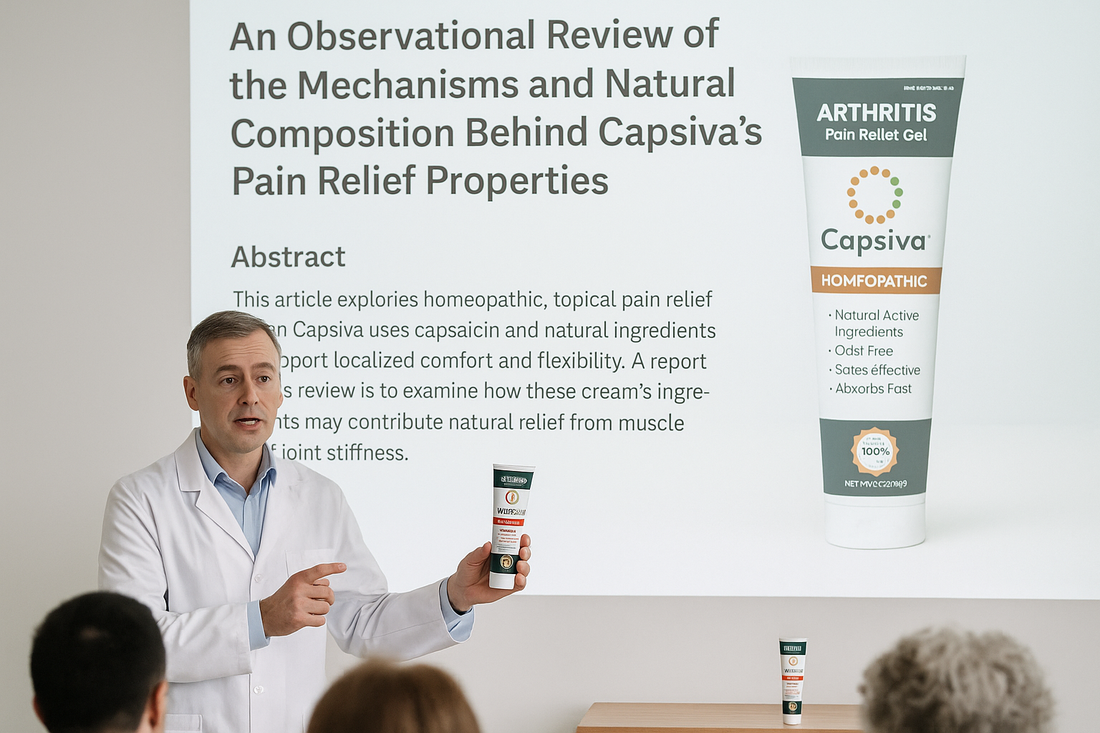
An Observational Review of the Mechanisms and Natural Composition Behind Capsiva’s Pain Relief Properties
Share
Topical pain relief creams have long been used to address joint stiffness, muscle soreness, and localized inflammation. Among these, capsaicin-based formulations have drawn growing attention for their naturally derived pain-relieving mechanisms.
Capsiva distinguishes itself through a homeopathic formulation that integrates capsaicin, a compound extracted from chili peppers, with other natural active components. It is designed to offer gentle topical comfort without odor, residue, or irritation — a significant advancement compared to traditional capsaicin products that often cause burning sensations.
This review examines the mechanisms by which Capsiva’s formula may influence comfort and mobility, as well as its differences from conventional synthetic topical agents.
Composition of Capsiva
Capsiva’s key ingredient is capsaicin, a bioactive alkaloid responsible for the heat sensation in chili peppers (Capsicum annuum). Capsaicin’s pain-modulating properties have been studied for decades in relation to sensory nerve desensitization.
In addition to capsaicin, Capsiva includes natural plant-based oils and extracts that serve as emollients and carriers, enhancing skin absorption and providing a soothing texture.
Key components include:
-
Capsaicin (Capsicum extract): Known to interact with TRPV1 receptors.
-
Botanical oils: Function as emollients, aiding delivery and moisturizing the skin.
-
Homeopathic dilutions: Applied following traditional homeopathic methodologies to maintain balance in the formula.
-
Water-based gel medium: Allows for rapid absorption and non-greasy application.
Mechanism of Action
1. Interaction with TRPV1 Receptors
Capsaicin acts on transient receptor potential vanilloid 1 (TRPV1) receptors, which are ion channels found in peripheral sensory neurons. These receptors play a role in detecting and regulating pain and temperature.
When capsaicin binds to TRPV1, it initially produces a warming sensation. With repeated application, this interaction can decrease the sensitivity of the receptors, a process known as defunctionalization. This mechanism is thought to reduce the frequency of discomfort signals transmitted from peripheral nerves to the central nervous system.
This biological desensitization explains why topical capsaicin has been studied for use in managing localized joint and muscle discomfort.
2. Increased Blood Flow
Topical capsaicin has been shown in research to produce localized vasodilation — an increase in blood flow near the skin’s surface. Improved circulation in the affected area may help support natural recovery processes and enhance tissue relaxation.
Capsiva’s formula capitalizes on this natural mechanism while maintaining comfort through its homeopathic balance, reducing the likelihood of excessive warmth or irritation.
3. Support for Natural Anti-Inflammatory Pathways
While Capsiva does not contain pharmaceutical anti-inflammatory agents, studies have suggested that natural capsaicin application may indirectly support the body’s own inflammation-modulating processes through the TRPV1 pathway.
Homeopathic formulations like Capsiva aim to align with these natural mechanisms rather than override them, promoting balance rather than suppression.
Comparison With Traditional Topical Agents
Traditional over-the-counter pain creams commonly use ingredients like menthol, camphor, or nonsteroidal anti-inflammatory drugs (NSAIDs). While effective for temporary relief, these formulations often rely on chemical irritants or synthetic compounds that can cause skin sensitivity or carry systemic risks with prolonged use.
Capsiva, in contrast, offers:
| Feature | Traditional Topical Agents | Capsiva |
|---|---|---|
| Active Ingredient | Menthol, camphor, or NSAIDs | Capsaicin (natural extract) |
| Sensation | Cooling or burning | Gentle warmth |
| Formulation Type | Synthetic compounds | Homeopathic and plant-based |
| Odor | Strong menthol or medicinal scent | Odor-free |
| Residue | Greasy or sticky | Non-greasy, fast-absorbing |
This distinction positions Capsiva as a natural, homeopathic alternative for individuals sensitive to conventional chemical-based options.
Observational Findings From Ingredient Research
While this review does not present original clinical data, an analysis of the literature on capsaicin and topical homeopathic formulations supports several consistent observations:
-
Capsaicin’s Desensitizing Effect: Multiple studies describe a reduction in local nerve sensitivity following regular topical use.
-
Improved Comfort and Function: Participants in various capsaicin studies have reported increased ease of movement in affected joints and muscles.
-
Favorable Tolerance Profile: Most capsaicin-based topical applications are considered well-tolerated, especially when formulated with moisturizing carriers.
-
Complementary Benefits: Natural plant extracts may further support skin comfort and hydration, improving overall application experience.
Capsiva builds on these findings by combining capsaicin’s studied properties with a homeopathic approach that avoids the burning effect traditionally associated with concentrated formulations.
Discussion: Homeopathic Approach and Safety Considerations
Homeopathy emphasizes stimulating the body’s natural responses rather than directly suppressing symptoms. In Capsiva, this philosophy guides the formulation process, ensuring the capsaicin concentration and accompanying natural agents remain balanced for gentle, topical application.
Capsiva’s non-pharmaceutical composition and FDA-compliant manufacturing suggest it can be considered a generally safe over-the-counter option for adults seeking comfort from stiffness or mild soreness.
However, users should always test small areas of skin before use, as sensitivity to natural ingredients can vary. It is also recommended that individuals consult a healthcare provider before using any new topical product, particularly those with underlying medical conditions or allergies.
Potential Applications
Capsiva’s design is best suited for individuals seeking:
-
Localized topical comfort for joints, hands, knees, or shoulders.
-
Non-greasy, odorless, fast-absorbing creams for daily routines.
-
Plant-based alternatives to synthetic pain relief creams.
-
Natural capsaicin roll-ons for convenient on-the-go application.
While results can vary from person to person, Capsiva’s homeopathic composition allows for flexible, frequent use without dependency or irritation concerns.
Conclusion
From a compositional and mechanistic standpoint, Capsiva represents a thoughtful integration of natural ingredients, homeopathic methodology, and capsaicin-based science.
Its approach differs from conventional topical products by prioritizing balance, absorption, and gentleness rather than aggressive desensitization or masking sensations.
While more formal clinical research would further validate Capsiva’s potential benefits, the available data on capsaicin’s natural interaction with the body’s pain and heat receptors supports its underlying design principles.
For those seeking an odor-free, non-greasy, and plant-based topical solution, Capsiva offers a homeopathic alternative rooted in evidence-based mechanisms rather than synthetic intervention — providing a natural path toward comfort and mobility in everyday life.
